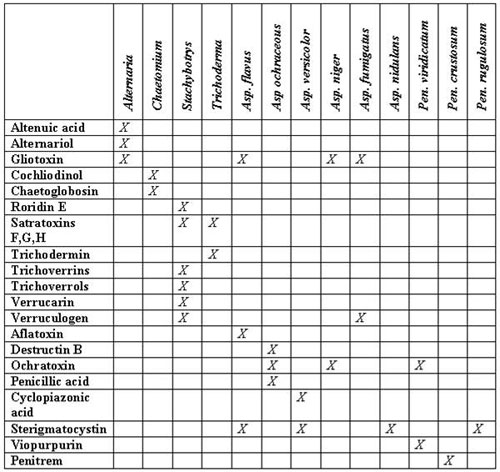|
Mycotoxins
By: Dr. Harriet Burge
We are
often asked what types of mycotoxins are produced by fungi and what types of health effects they cause.
Fungi produce hundreds of mycotoxins,and yes, some of these toxins are produced by some common indoor
fungi. A very short list of some familiar fungi and their mycotoxins is presented in Table 1.
Table 1. Abbreviated list of some familiar fungi and some of their mycotoxins.

However, a few comments about the importance, or lack thereof, of these mycotoxins in indoor air-related
illness are needed.
1. Toxigenic means that the fungus is capable of producing toxins. It doesn't mean that they always do, or
that the presence of a specific fungus can be taken to mean that the toxins are being produced. Even though
a fungal species is known to have strains that produce mycotoxins, not all strains have this capability,
and even those with the capability do not make the toxins under all conditions. Unfortunately, little data
is available in these areas for fungi other than Stachybotrys, Aspergillus, and a few
others.
2. If you want to know whether or not toxins are present, you must sample for the toxin itself. There are
an increasing number of toxin assays available. My caution about using these services is to be sure that
any sample collection and analysis is hypothesis driven, and that you know how you are going to interpret
the data once you have it.
3. Mycotoxins are not volatile, and inhalation exposure is probably primarily related to airborne spores.
4. Health effects for most of the mycotoxins are known only from either agricultural environments, or from
laboratory experiments, and virtually all of the data involves ingestion of the mycotoxins.
5. Extrapolating from the amount of toxin necessary to cause health effects by ingestion, and, given that
the toxin content of individual spores is quite low, inhalation exposure in non-agricultural environments
(i.e. in normal homes and offices) to enough spores of even the most toxic strains to reach a dose likely
to produce human health effects is unlikely and probably very rare.
6. Concentrating on the so-called toxigenic fungi in indoor environmental investigations is only
appropriate if you are only concerned about specific symptoms that you are convinced could only be due to
the mycotoxins (I personally don't know what those symptoms would be). To ignore the other fungi is to
ignore potentially hazardous conditions that could lead to serious respiratory diseases (I know none of you
would do that!).
One final reminder: Most field investigators should not be investigating health effects, but rather the
conditions that lead to fungal growth and the means for correcting those conditions. Focusing on health
effects (which is implicit when concentrating on mycotoxins) when you don't have the credentials to back up
your opinions may eventually get you into very hot water!
|

